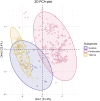Ecological modeling, biogeography, and phenotypic analyses setting the tiger cats' hyperdimensional niches reveal a new species
- PMID: 38287072
- PMCID: PMC10825201
- DOI: 10.1038/s41598-024-52379-8
Ecological modeling, biogeography, and phenotypic analyses setting the tiger cats' hyperdimensional niches reveal a new species
Abstract
Recently, the tiger-cat species complex was split into Leopardus tigrinus and Leopardus guttulus, along with other proposed schemes. We performed a detailed analysis integrating ecological modeling, biogeography, and phenotype of the four originally recognized subspecies-tigrinus, oncilla, pardinoides, guttulus-and presented a new multidimensional niche depiction of the species. Species distribution models used > 1400 records from museums and photographs, all checked for species accuracy. Morphological data were obtained from institutional/personal archives. Spotting patterns were established by integrating museum and photographic/camera-trap records. Principal component analysis showed three clearly distinct groups, with the Central American specimens (oncilla) clustering entirely within those of the Andes, namely the pardinoides group of the cloud forests of the southern Central-American and Andean mountain chains (clouded tiger-cat); the tigrinus group of the savannas of the Guiana Shield and central/northeastern Brazil (savanna tiger-cat); and the guttulus group in the lowland forests of the Atlantic Forest domain (Atlantic Forest tiger-cat). This scheme is supported by recent genetic analyses. All species displayed different spotting patterns, with some significant differences in body measurements/proportions. The new distribution presented alarming reductions from the historic range of - 50.4% to - 68.2%. This multidimensional approach revealed a new species of the elusive and threatened tiger-cat complex.
© 2024. The Author(s).
Conflict of interest statement
The authors declare no competing interests.
Figures








Similar articles
-
Assessing microhabitat, landscape features and intraguild relationships in the occupancy of the enigmatic and threatened Andean tiger cat (Leopardus tigrinus pardinoides) in the cloud forests of northwestern Colombia.PLoS One. 2023 Jul 10;18(7):e0288247. doi: 10.1371/journal.pone.0288247. eCollection 2023. PLoS One. 2023. PMID: 37428730 Free PMC article.
-
Extensive Phylogenomic Discordance and the Complex Evolutionary History of the Neotropical Cat Genus Leopardus.Mol Biol Evol. 2023 Dec 1;40(12):msad255. doi: 10.1093/molbev/msad255. Mol Biol Evol. 2023. PMID: 37987559 Free PMC article.
-
The dominant mesopredator and savanna formations shape the distribution of the rare northern tiger cat (Leopardus tigrinus) in the Amazon.Sci Rep. 2022 Nov 4;12(1):18697. doi: 10.1038/s41598-022-21412-z. Sci Rep. 2022. PMID: 36333380 Free PMC article.
-
Securing a future for wild Indochinese tigers: Transforming tiger vacuums into tiger source sites.Integr Zool. 2010 Dec;5(4):324-334. doi: 10.1111/j.1749-4877.2010.00220.x. Integr Zool. 2010. PMID: 21392350 Review.
-
The Andes through time: evolution and distribution of Andean floras.Trends Plant Sci. 2022 Apr;27(4):364-378. doi: 10.1016/j.tplants.2021.09.010. Epub 2022 Jan 6. Trends Plant Sci. 2022. PMID: 35000859 Review.
Cited by
-
The Nariño Cat, the Tigrinas and Their Problematic Systematics and Phylogeography: The Real Story.Animals (Basel). 2025 Jun 26;15(13):1891. doi: 10.3390/ani15131891. Animals (Basel). 2025. PMID: 40646789 Free PMC article.
-
Distribution and habitat use patterns of the endangered Central American clouded oncilla (Leopardus pardinoides oncilla) in Costa Rica.PLoS One. 2024 Sep 17;19(9):e0310562. doi: 10.1371/journal.pone.0310562. eCollection 2024. PLoS One. 2024. PMID: 39288115 Free PMC article.
-
Global scale assessment of the human-induced extinction crisis of terrestrial carnivores.Sci Adv. 2025 Jul 18;11(29):eadq2853. doi: 10.1126/sciadv.adq2853. Epub 2025 Jul 16. Sci Adv. 2025. PMID: 40668902 Free PMC article.
References
-
- Cabrera, A. Catálogo de los mamíferos de América del Sur. Rev. del Mus. Argentino Ciencias Nat. Bernardino Ridavadia Zool. 1–370 (1958).
-
- Wozencraft WC. Order carnivora. In: Wilson DE, Reeder DM, editors. Mammal Species of the World: A Taxonomic and Geographic Reference. John Hopkins University Press; 2005. pp. 532–628.
-
- Kitchener, A. C. et al. A revised taxonomy of the Felidae. The final report of the Cat Classification Task Force of the IUCN/SSC Cat Specialist Group. Cat News Spec. Issue 80 (2017).
-
- Nowell K, Jackson P. Wild Cats: Status Survey and Conservation Action Plan. IUCN/SSC Cat Specialist Group; 1996.
MeSH terms
LinkOut - more resources
Full Text Sources
Miscellaneous

